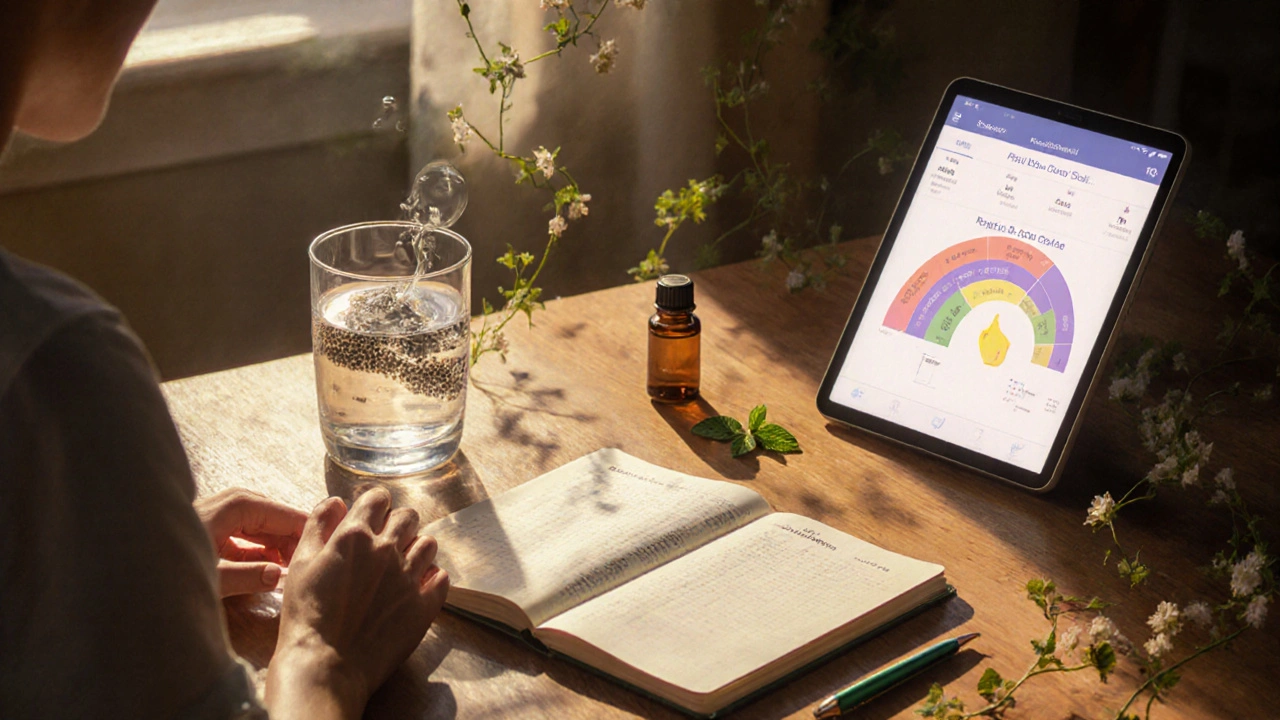Living with IBS-Mixed means your gut doesn’t know what it wants. One day you’re stuck on the toilet for hours, straining with hard stools. The next, you’re racing to the bathroom, barely making it in time. This back-and-forth isn’t just inconvenient-it’s exhausting. You’re not alone. About 1 in 5 people with IBS experience this rollercoaster of constipation and diarrhea, a pattern officially called IBS-Mixed (IBS-M). Unlike Crohn’s or colitis, there’s no inflammation or damage to see on a scan. But your gut is still in chaos: too slow, then too fast, with pain, bloating, and gas tagging along for the ride.
Why IBS-Mixed Is So Hard to Treat
Most IBS treatments target one direction: either constipation or diarrhea. But IBS-Mixed demands a tightrope walk. Take a laxative to fix one episode, and you might trigger the next. Use an antidiarrheal like loperamide, and your next bowel movement could turn into a brick. This isn’t your fault. It’s how the condition works.
Studies show that medications designed for IBS-C or IBS-D often fail in IBS-M. For example, linaclotide helps 48% of constipation-predominant patients, but only 22% of those with mixed symptoms. Eluxadoline works for diarrhea-predominant cases, but barely helps IBS-M. That’s because the root causes are layered: abnormal gut motility, hypersensitive nerves, and a gut microbiome out of balance. You can’t fix one without considering the other.
Diagnosis: Ruling Out the Big Ones First
Before accepting an IBS-M diagnosis, your doctor should check for other conditions. That means blood tests for anemia, inflammation (CRP), and celiac disease. If you’re over 50, or have weight loss, bleeding, or a family history of colon cancer, a colonoscopy might be needed. IBS is a diagnosis of exclusion-meaning other things must be ruled out first.
The Rome IV criteria are the gold standard: you must have abdominal pain at least once a week for three months, with symptoms starting at least six months prior. Crucially, your stools must alternate between hard/lumpy (Bristol Scale 1-2) and loose/watery (Bristol Scale 6-7) in at least 25% of bowel movements. That’s not a guess-it’s a measurable pattern.
The Low FODMAP Diet: Your Best Shot at Control
Of all the tools available, the low FODMAP diet has the strongest evidence for IBS-M. It’s not a weight-loss plan or a gluten-free fad. It’s a science-backed elimination protocol that removes specific fermentable carbs that feed bad gut bacteria and pull water into the intestines.
Here’s how it works in practice:
- Elimination (2-6 weeks): Cut out high-FODMAP foods like onions, garlic, wheat, apples, milk, beans, and artificial sweeteners. Stick to safe options like rice, oats, bananas, carrots, and lactose-free dairy.
- Reintroduction (8-12 weeks): Add back one FODMAP group at a time, every 3 days. Track symptoms closely. This tells you exactly which foods trigger you.
- Personalization: Keep only the foods you tolerate. You don’t need to avoid everything forever.
A 2021 study in Gastroenterology found 50-60% of IBS-M patients saw major symptom improvement. That’s lower than the 70-75% seen in IBS-D, but still better than most drugs. Reddit users report cutting symptom days from 25 to 8 per month after sticking with it. The catch? You need guidance. Do it alone, and you risk nutrient gaps or unnecessary restrictions. Work with a dietitian trained in FODMAPs.
Medications: The Balancing Act
There’s no single pill for IBS-M. But smart use of two medications can help you ride the waves.
For constipation episodes: Use a gentle osmotic laxative like polyethylene glycol (Miralax, 17g daily). It pulls water into the colon without causing cramps. Avoid stimulant laxatives-they’re too harsh and can backfire.
For diarrhea episodes: Loperamide (Imodium, 2-4mg as needed) slows things down. But don’t use it daily. It can worsen constipation and bloating over time.
Antispasmodics like dicyclomine (10-20mg up to four times a day) help with cramping and pain. They work across all IBS types and are often well-tolerated. Peppermint oil capsules (enteric-coated, like IBgard) reduce bloating and pain in 68% of users, according to Amazon reviews. Just avoid them if you have acid reflux-they can relax the lower esophageal sphincter.
Antidepressants are unexpectedly effective. Low-dose tricyclics (like amitriptyline, 10-25mg at night) don’t treat depression here-they calm overactive gut nerves. Studies show 55-60% of IBS-M patients get better with them, better than any other subtype. SSRIs like sertraline help too, but tricyclics win for pain control.

Stress Isn’t Just in Your Head-It’s in Your Gut
Over half of IBS-M patients say stress makes their symptoms worse. That’s not coincidence. Your gut and brain are wired together by the vagus nerve. Anxiety doesn’t cause IBS, but it turns up the volume on your symptoms.
Cognitive behavioral therapy (CBT) is one of the most powerful tools you can use. A 2021 guideline from the American Gastroenterological Association gave CBT a strong recommendation based on 12 trials. People using CBT saw symptom scores drop by 40-50%. That’s better than most drugs. Online CBT programs like those from Cara Care or The IBS Network are affordable and effective.
Other stress-reduction techniques-mindfulness, yoga, diaphragmatic breathing-also help. You don’t need hours a day. Ten minutes of slow breathing before bed can reduce nighttime cramping and improve sleep, which in turn lowers overall gut sensitivity.
Tracking Your Symptoms: The Secret Weapon
Most people with IBS-M guess their triggers. That’s why they fail. The key is tracking.
For four weeks, write down:
- Each bowel movement (use the Bristol Stool Scale: 1 = hard lumps, 7 = watery)
- Pain level (0-10)
- Food and drink consumed
- Stress level (low, medium, high)
- Medications taken
Apps like Cara Care or Bowel Diary make this easy. A 2022 study showed people using apps improved symptoms 35% more than those using paper logs. Patterns emerge: maybe your diarrhea always follows coffee, or your constipation spikes after stress meetings. You can’t fix what you can’t measure.
What Doesn’t Work (And Why)
Many people try the wrong things-and waste months doing it.
- Just cutting out gluten: Only 10-15% of IBS-M patients improve on a gluten-free diet. It’s often the FODMAPs in wheat (fructans), not gluten, causing the problem.
- Probiotics without knowing which strain: Not all probiotics help. VSL#3 and Bifidobacterium infantis 35624 have evidence. Others? Not so much.
- Overusing fiber supplements: Insoluble fiber (wheat bran) can worsen bloating. Stick to soluble fiber like psyllium husk (5g daily), which softens stool without gas.
- Waiting for a cure: There isn’t one. IBS-M is chronic, not curable. But it’s manageable. Focus on control, not elimination.

What’s Coming Next
Research is moving fast. In 2023, a new drug called ibodutant showed 45% symptom improvement in IBS-M patients-nearly double the placebo effect. It’s not approved yet, but it’s promising. AI-powered gut microbiome tests like Viome are also emerging, offering personalized diet plans based on your unique bacteria. Early results show 58% symptom reduction.
But the biggest change might be in how doctors think. The Rome V criteria, expected in 2024, will raise the bar: alternating symptoms must occur in 30% of bowel movements, not 25%. That means fewer misdiagnoses and more targeted care.
Meanwhile, healthcare gaps remain. IBS-M is diagnosed 37% less often in racial minorities and 29% less in rural areas. If you’re struggling to get help, push for it. You deserve accurate care.
Real-Life Strategies That Work
Here’s what real people with IBS-M are doing right:
- Keep two meds on hand: Miralax for constipation, Imodium for diarrhea. Use them only when needed.
- Take peppermint oil capsules daily-68% report less pain and bloating.
- Combine psyllium husk (5g) with plenty of water. It smooths out both constipation and diarrhea.
- Use a symptom tracker app for at least 30 days. You’ll spot your triggers.
- Try 10 minutes of daily breathing exercises. It’s free, and it lowers your gut’s sensitivity.
It takes 3-6 months to get good at this. Most people give up before then. But if you stick with tracking, diet, stress control, and smart meds, you’ll go from feeling out of control to feeling in charge. You won’t be cured-but you’ll be free.
Can IBS-Mixed turn into Crohn’s disease or ulcerative colitis?
No. IBS-Mixed is a functional disorder, meaning there’s no structural damage or inflammation in the gut. Crohn’s and ulcerative colitis are inflammatory diseases with visible damage. IBS doesn’t progress into these conditions. However, symptoms can overlap, which is why doctors rule out inflammatory bowel disease before diagnosing IBS.
Why do some days I’m constipated and others I’m diarrhea?
This fluctuation comes from irregular gut motility. Your intestines sometimes contract too slowly (causing constipation) and other times too quickly (causing diarrhea). Stress, food triggers, and gut bacteria imbalances can push your system from one extreme to the other. It’s not random-it’s your nervous system overreacting to normal signals.
Should I avoid dairy if I have IBS-Mixed?
Not necessarily. Many people with IBS-M mix up lactose intolerance with IBS. Dairy can be a trigger if it contains lactose (a FODMAP), but lactose-free milk or hard cheeses are usually fine. The best way to know is to test it during the reintroduction phase of the low FODMAP diet.
Can I use fiber supplements every day?
Yes-if you choose the right kind. Soluble fiber like psyllium husk (Metamucil) helps both constipation and diarrhea by absorbing water and adding bulk gently. Avoid insoluble fiber like wheat bran-it can worsen bloating and cramping. Start with 5g daily and increase slowly with plenty of water.
How long does it take to see results from the low FODMAP diet?
Most people notice improvement within 2-6 weeks of strict elimination. But the full benefit comes after reintroducing foods to find your personal triggers. The whole process takes 8-12 weeks. Don’t rush it. Skipping reintroduction means you might avoid foods you could actually tolerate.
Are there any new medications for IBS-Mixed?
Yes. A new drug called ibodutant showed 45% symptom improvement in phase 3 trials for IBS-M in 2023. It’s not approved yet, but it’s one of the first designed specifically for mixed symptoms. Other drugs like tenapanor and eluxadoline are approved for IBS-C and IBS-D, respectively, but not IBS-M. For now, doctors use combinations of existing meds off-label.
What to Do Next
Start with a symptom diary for four weeks. Use an app if you can. Then, talk to your doctor about ruling out celiac and inflammation. If you’re cleared for IBS-M, ask for a referral to a dietitian who specializes in FODMAPs. Don’t try to do it alone. Then, consider a low-dose tricyclic antidepressant if pain is your main issue. And if stress is overwhelming, try a 10-week online CBT program. You don’t need to fix everything at once. One step at a time, you’ll build control over your gut-and your life.

